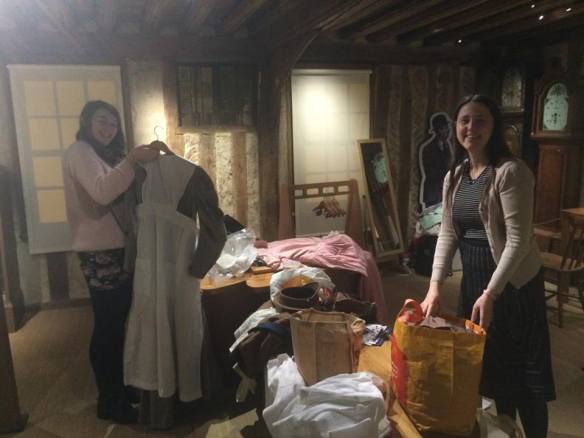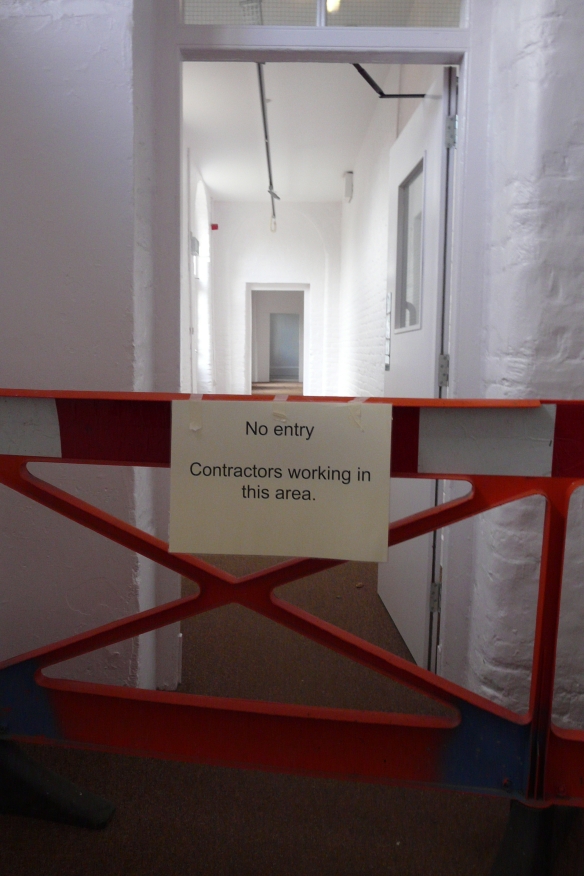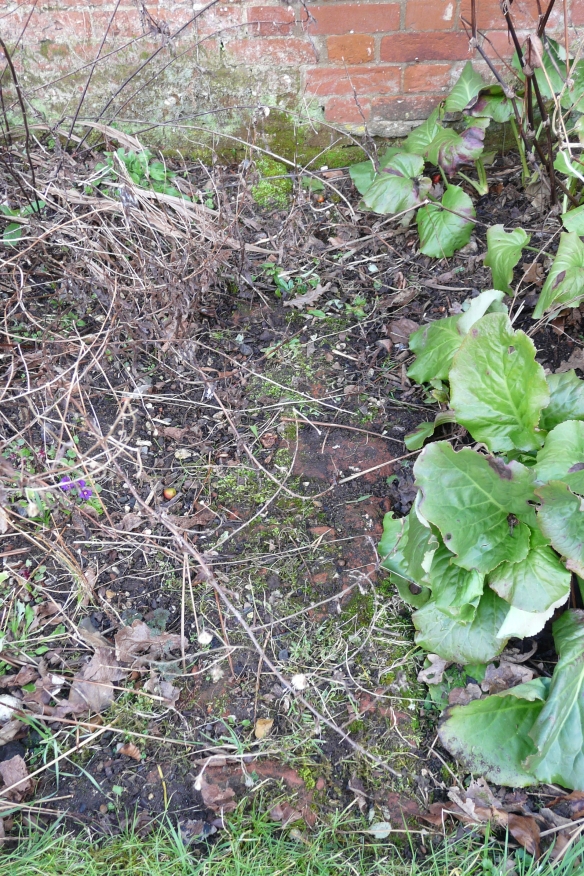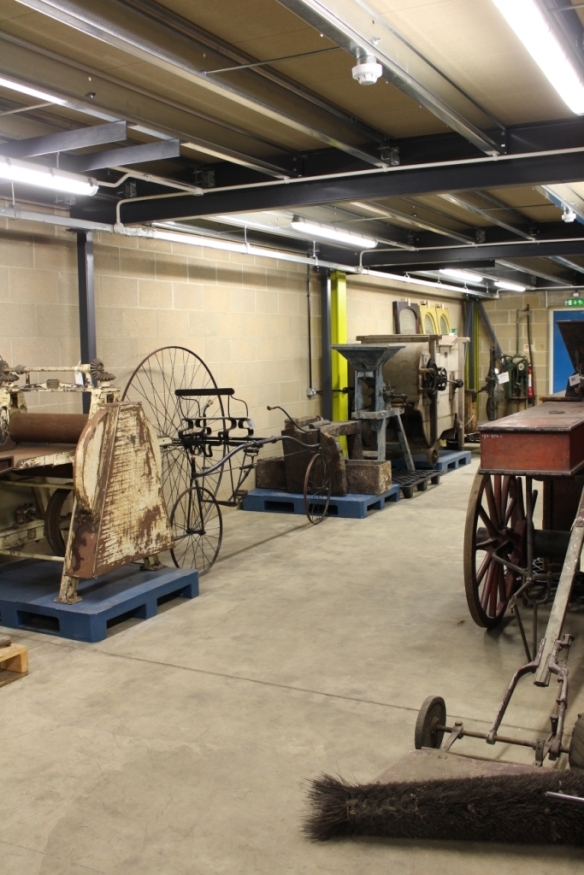Hello all Tabitha here again! This is officially my last blog post before my traineeship comes to a close in March – boo hoo! – However I shall do my best to sum up events from my last blog, and hopefully what is still to come.
As I mentioned at the end of my last blog post, Ancient House was preparing for the big Thetford Lights On event on the 28th November. The museum opened its doors from 5pm until 9pm to welcome the whole town to an Edwardian Christmas! There were Edwardian fete style games, an RFC officer, a singing soldier, lavender bags to make, skittles, plus the chance for the public to handle museum objects. I was based in the kitchen making peppermint creams, which I think was popular for all ages! We also lit our open range and had a Christmas pudding and some mulled cider on the boil, where visitors could grind up spices to add to the mix.
 The house really did feel alive, plus we added decorations of holly branches and Edwardian Christmas cards really did get me in the mood for Christmas! However after a couple of hours in a long skirt and high neck blouse, constantly checking if the range needed feeding (and every now and again relighting it) I soon felt a real sense of how easy we have it nowadays! We didn’t have anything cooking in the range, but it still took constant effort to keep it going while at the same time trying to prepare sweets – a very simple recipe! I have full respect for anyone of the past who wore a skirt or restrictive clothes and did half the things we do today. I do strongly believe that to experience something is to really understand it, and the experience of an Edwardian kitchen will stay with me forever.
The house really did feel alive, plus we added decorations of holly branches and Edwardian Christmas cards really did get me in the mood for Christmas! However after a couple of hours in a long skirt and high neck blouse, constantly checking if the range needed feeding (and every now and again relighting it) I soon felt a real sense of how easy we have it nowadays! We didn’t have anything cooking in the range, but it still took constant effort to keep it going while at the same time trying to prepare sweets – a very simple recipe! I have full respect for anyone of the past who wore a skirt or restrictive clothes and did half the things we do today. I do strongly believe that to experience something is to really understand it, and the experience of an Edwardian kitchen will stay with me forever.
The final big event before Christmas was an Edwardian Murder Mystery by Ancient House Teenage History Club. The plan was for three groups with ‘detective notes’ to visit each room to hear the stories of the characters, which the teenagers played fantastically! After spending the term previously preparing for the event, including three weeks working with storyteller Dave Tong, they really did brilliantly and were even prompting questions from the audience without fault. The suspects were all asked to have a final round of questioning in the hall, before the audience made a ballot of who they thought the murderer was – with the majority choosing wrong! The mystery was named a success by everyone, so I think another will definitely be in future plans.

The glamorous aftermath of sorting costumes and props with Melissa!
Last but by no means least, 11th of December saw the 90th Birthday of Ancient House! That evening in the Carnegie Rooms in Thetford was a grand affair to celebrate the occasion and fundraise for a new redisplay in the museum to tell the story of Maharajah Duleep Singh and his family. The room was filled with cocktail dresses, suits and spicy smells from the fantastic three course meal provided by Punjab, the UK’s oldest North Indian restaurant. It really was a fantastic evening, and marked the start great ninetieth year to come for the museum and all involved – plus many years to come!

Lovely piece in the newspaper too, although didn’t realise I was going to be in it!

Then all of a sudden it was 2015!
After a lovely Christmas and New Year the museum was back into the swing of things, and I was back into my traineeship with my first new experience being… the Strangers Hall deep clean!
 Before I started many people were saying comments such as ‘wrap up warm’, ‘wear layers’ and ‘don’t forget extra socks!’, but after a morning on training on Friday 9th and meeting the other members of staff and volunteers involved I was very excited – and not too cold! Although I could only give one day to the clean it really was great experience of how much work needs go into keeping a historic building up to date and as clean as possible. Despite the known problems all historic museums must have to constantly battle with, we completed more than I thought was possible in just one day. I was in Lady Paine’s bedroom which involved the four poster bed spread needing to be stripped and packed for freezing! The day really highlighted to me how much prior organisation and planning is essential to a feat like the deep clean. Everyone ensured there were the correct stations of tables and equipment set up, and people prepped for their rooms and working together. I hope it goes just as smoothly for the rest of the deep clean, good luck all involved!
Before I started many people were saying comments such as ‘wrap up warm’, ‘wear layers’ and ‘don’t forget extra socks!’, but after a morning on training on Friday 9th and meeting the other members of staff and volunteers involved I was very excited – and not too cold! Although I could only give one day to the clean it really was great experience of how much work needs go into keeping a historic building up to date and as clean as possible. Despite the known problems all historic museums must have to constantly battle with, we completed more than I thought was possible in just one day. I was in Lady Paine’s bedroom which involved the four poster bed spread needing to be stripped and packed for freezing! The day really highlighted to me how much prior organisation and planning is essential to a feat like the deep clean. Everyone ensured there were the correct stations of tables and equipment set up, and people prepped for their rooms and working together. I hope it goes just as smoothly for the rest of the deep clean, good luck all involved!
As well as the deep clean I have been able to attend a Share Museums East training session last week at Mildenhall & District Museum. The day was focusing on Stone Age to Iron Age, broadening our ideas of activities and sessions on the topic. It was a great day, and as it is a topic being tackled by more and more schools I felt the day really expanded my knowledge of the era. It was also fantastic as always to exchange ideas for delivery through sharing and talking with other museum staff and volunteers – something I regard highly for any topic or subject.

Some ideas on big paper is always good!

#MuseumSelfie Couldn’t help myself but chat to a friendly Roman about the great redisplays in the Mildenhall & District Museum currently underway!
So that’s a brief sum up of what’s happened so far since my last post here. However there is one other rather big feat that I am attempting for the first time with fantastic support and encouragement from Ancient House; A Sleepover in the Museum!
As part of the GEM Museum Learning course I am part of we were asked to produce a work based assignment, and I perhaps rather ambitiously decided to organise a unique experience of a Sleepover in the Museum – and it will be the first time this has happened! Out of work I am a Girlguiding UK leader in training, and have been involved in guiding all my life (I was taken on the first guide camp at the ripe age of a few months!). I feel that Girlguiding UK as a whole is a rather ‘untapped market’ as people in business might say, and the organisation could be part of a fantastic partnership with local museums and heritage sites. Therefore I have decided to target the exclusive offer only to Guide groups to try and bridge this gap, and also to draw on some of my out-of-work knowledge in Guiding.

Please share this poster if you know any Guide leaders who might be interested!
Guides will be able to explore the museum after dark and discover the museum stores and cellar usually closed to the public. Activities also include a torch-lit tour, making your own ‘mini-museum’, handling real historical artefacts, meeting characters from when the house was new, and discovering the role of an Archaeologist and making an intriguing dessert called Palaeontologist Pudding!
Despite the fact that starting in late November to organise an event of this scale before mid-February, and be written into a case study appearing impossible at certain times, it is going successfully and I can’t lie that I am incredibly excited for when the evening comes next month. Part of deciding to organise such a large assignment was because of the experience I will gain from the administration side of creating this event, which is an area I wished to improve on and already feel more confident in certain areas of this. Moreover I feel incredibly privileged to be able and actually allowed to hold an event like this, and I can’t thank Oliver, Melissa, and all the Ancient House staff for being so helpful and supportive in this huge feat!
So that’s it, my ramblings have come to an end, and I have loved every single second of it! Despite trying not to sound too cliché, I can honestly say that the last year has been one of the best experiences of my life. I’ve done amazing things and met extraordinary people, and learnt an incredible amount about museums, learning, history, and – again cliché – myself. I will never forget the astounding opportunities I have been offered during my traineeship, as well as the freedom and trust to push myself into new things. I really will miss Ancient House, the Fenland Lives & Land Project, NMS and everyone I’ve had the privilege of meeting and learning from during my time. My mind is certain that the museum life is the life for me – who would have thought that of the little girl running around dressed as King Arthur thirteen years ago!
A highlight for me has to be Curator Oliver Bone giving a short talk at the 90th Birthday meal on the recipe for success in a museum. A main ingredient Oliver concluded with was love, which I completely understand. During my traineeship I really have met brilliant people and been part of amazing things, and these have come from love – peoples love for history, for wonderful objects, for constant curiosity, for learning, for friendship, and so many more things I could mention.
Thank you for everything, signing out!
Tabitha Runacres
Heritage Learning Trainee
Ancient House Museum, and the Fenland Lives & Land Project.











































